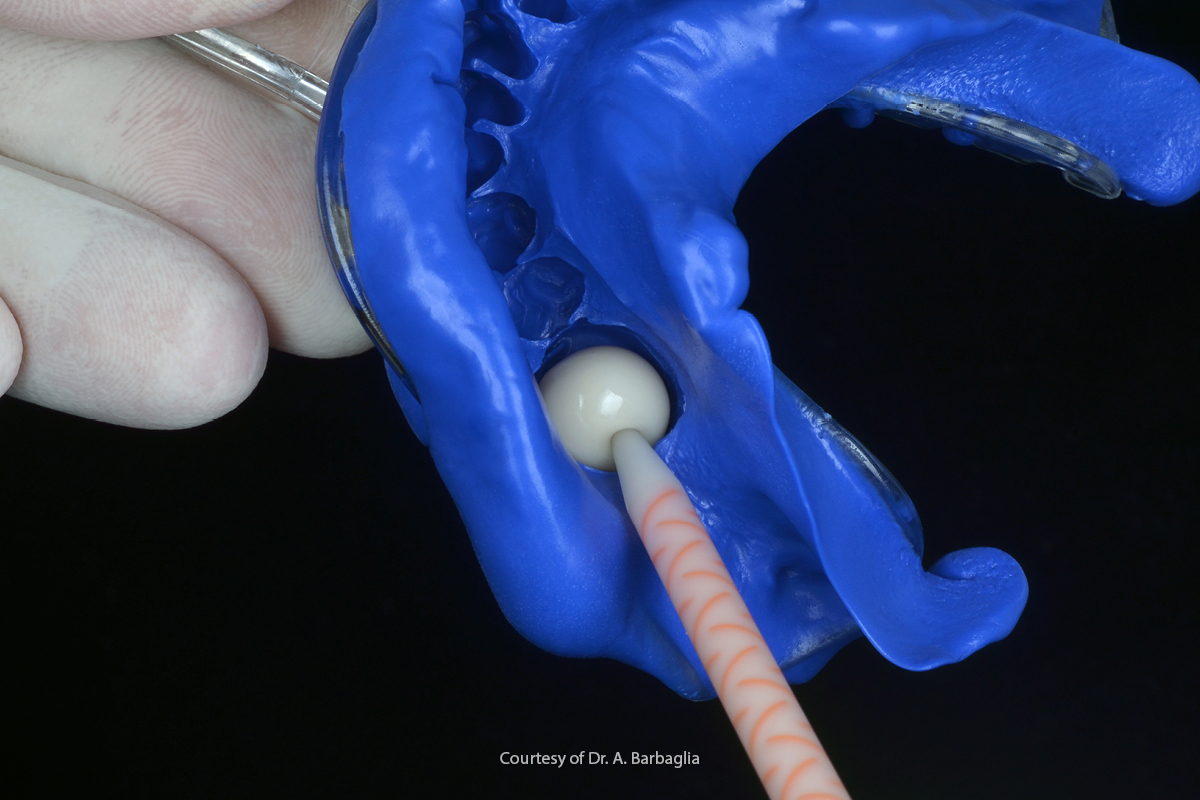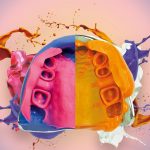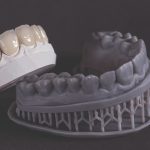
Synthetic resins are currently used to produce prosthetic elements such as temporary crowns, temporary bridges, frameworks and hooks for dentures and to create orthodontic appliances and gnathological devices.
In order to be used in all these clinical situations, resins must possess the following characteristics:
- Chemical and dimensional stability
- Cosmetic characteristics able to mimic oral cavity tissues
- The mechanical characteristics required for the use they are intended for. More specifically, they must be elastic in order to resist masticatory loads
- Insoluble in oral fluids
- Flavourless, odourless and non-toxic
- Low specific weight
- Easy to work and repair
- Inexpensive
Thermoplastic and thermosetting resins are two kinds of polymer that differ in the kind of reaction they present when heat is applied.
The most significant difference is that once they have been heated and subsequently cooled, thermosetting resins can no longer be modified or modelled, whereas thermoplastic resins are hard at room temperature but, when heated, they become malleable and modellable until they are cooled; during this process, the chemical structure does not change, and it can be repeated multiple times.
Thermoplastic resins have a lower melting point, whereas thermosetting resins can resist at higher temperatures without losing their structural integrity.
Thermoplastic resins
Thermoplastic resins soften when heated and become increasingly fluid with the increase in the heat applied. The process is completely reversible and no new chemical bond is formed. They are polymers with a linear or branched molecular structure, when heated they gradually become softer and can be worked by plastic deformation. If cooled, they once again adopt a rigid behaviour and maintain the form they have been given. The transition from a rigid state to a plastic one is therefore reversible and occurs every time the material is subject to a heating cycle.
Most thermoplastic resins afford high resistance and a certain flexibility, a quality that makes these resins a popular choice, particularly for dentures.
They have a number of advantages: they are resistant, light, inexpensive and easy to handle.
Their disadvantages include a very low melting point, and they have a poor resistance to organic solvents and polar solvents.
They are also susceptible to permanent deformation and failure if subject to continuous stress, such as masticatory stress. The material’s susceptibility to deformation is exacerbated by its low melting point.
The indications for thermoplastic resins are: partial dentures, preformed hooks, full dentures structures, temporary bridges and crowns and orthodontic appliances. They are monomer-free and therefore non-toxic and nonallergenic; they are used by injection, are biocompatible, have excellent cosmetic properties and are comfortable to wear.
The thermoplastic resins category includes:
- Acetal resins
- Polyamide resins
- Polystyrene resins
- Acrylic resins
On account of their high abrasion- and failure-resistance, combined with good elasticity, acetal resins are ideal for pre-formed hooks, artificial teeth and frameworks for dentures, as well as temporary bridges and occlusal splints. However, on a cosmetic level, they have poor translucence that is far inferior to that of acrylic or polycarbonate resins.
Polyamide resins (nylon) afford great flexibility, and mechanical, heat and corrosion resistance. These characteristics make nylon an excellent substitute for metal and it is used above all in mucosal-supported dentures. Due to its flexibility it cannot be used as an occlusal splint and to make artificial teeth. It is often used in patients who are hypersensitive to methacrylate.
Polystyrene resins are a popular choice in dentistry, they have good failure resistance and flexibility but poor abrasion resistance. They have good translucence, they can be polished and they are used for temporary prostheses and frameworks for dentures.
Acrylic resins were developed for the production of full dentures. They are inelastic but have a high mechanical resistance. They have excellent dimensional stability and a smooth, dense surface. They are used to make temporary crowns and bridges, as a coating for crowns and bridges, denture frameworks and artificial teeth.
The main difference between thermoplastic acrylic resins and classic acrylic resins is that thermoplastic ones do not release monomers, a characteristic that makes then non-toxic.
Polymethyl methacrylate (PMMA) is extensively used to manufacture artificial teeth and the bases of full dentures.
Thermosetting resins
These resins have a cross-linked structure that makes them rigid at any temperature (they do not have a glass transition temperature). As they cannot be worked in a rigid state, the industry does not produce them with their definitive structure and they are produced in two steps. During the first partial polymerisation phase, these resins take on a linear structure, and present characteristics similar to thermoplastic resins as they are able to pass from a rigid to a plastic state when heated. At this point they can be worked, for example by moulding.
Once shaping is complete, heating causes a second polymerisation phase, in which transverse bonds form between the molecules to given the definitive cross-linked structure.
Unlike thermoplastic resins, once they have set, thermosetting resins maintain their excellent physical properties and cannot be reworked.
They can have different colours and different surface finishes. They offer good performance in terms of resistance to weight. They conduct heat. They are corrosion- and water-resistant. They are inexpensive.
They do, however, present certain disadvantages, such as low initial viscosity and they require secondary intervention to remove excesses. When present with a limited thickness, they tend to have a poor tensile strength and good ductility.
Epoxy resins, for example, have a thermosetting behaviour, and once cured they cannot be modified using heat. They are used to make abutments and models.
References
Rokaya, D., Srimaneepong, V., Sapkota, J., Qin, J., Siraleartmukul, K., & Siriwongrungson, V. (2018). Polymeric materials and films in dentistry: An overview. Journal of Advanced Research, 14, 25-34.
Ardelean, L., Bortun, C. M., Podariu, A. C., & Rusu, L. C. (2015). Thermoplastic resins used in dentistry. Thermoplastic Elastomers. Synthesis and Applications. Rjeka: InTech, 145-167.
Chuchulska, B., Yankov, S., Hristov, I., & Aleksandrov, S. (2018). Thermoplastic materials in the dental practice: a review. Int. J. Sci. Res, 6(12), 1074-1076.
Want to know more about our Acrytemp temporary restorative resin?
Go to product


 Zhermack SpA has been one of the most important producers and international distributors of alginates, gypsums and silicone compounds for the dental sector for over 40 years. It has also developed solutions for the industrial and wellbeing sectors.
Zhermack SpA - Via Bovazecchino, 100 - 45021 Badia Polesine (RO), Italy.
Zhermack SpA has been one of the most important producers and international distributors of alginates, gypsums and silicone compounds for the dental sector for over 40 years. It has also developed solutions for the industrial and wellbeing sectors.
Zhermack SpA - Via Bovazecchino, 100 - 45021 Badia Polesine (RO), Italy.


